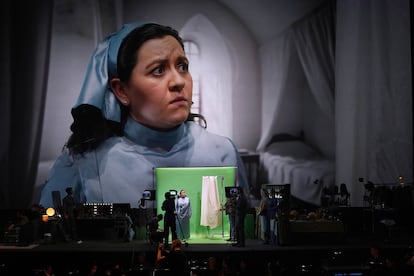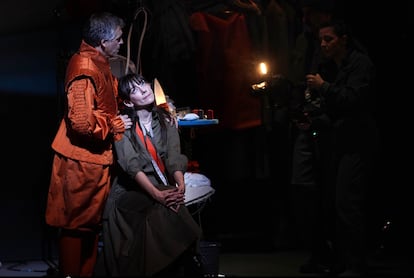The ghostly tremolo of the vibraphone, a chromatic duet of the soprano with a cello and the ascension of a clarinet. Three sound strokes to introduce one of the most popular roundels in Spanish literature sung by a baritone: “Isn’t it true, angel of love / that on this secluded shore / the moon shines purer / and you breathe better?”
It is the most memorable passage of Tenorio, the seventh opera by Spanish composer Tomás Marco (Madrid, 81 years old). One more example of his mastery in creating operatic moments halfway between dream and madness, but also a solitary musical flash in a long, monotonous score with little dramatic flight that the Teatro Real premiered in a stage version last Monday, may 13th.
After Sigismund (2003), based on Calderón de la Barca and the Knight of the Sad figure (2004) founded on Cervantes, Marco has focused Tenorio (2009) in Zorrilla’s classic. A commission from the extinct Estío Musical Burgalés that the economic crisis forced to cancel until, in 2017, a Leonardo Grant from the BBVA Foundation allowed its premiere in a concert version, at El Escorial, and its recording, at Cezanne Producciones.
Tenorio It is a chamber opera with a libretto by Marco himself, who adds to Zorrilla recognizable fragments from other authors such as Tirso, Da Ponte or Quevedo. A dramatic construction that reflects on the myth of Don Juan, lasting just under two hours without interruption, framed between a prologue and an epilogue with seven scenes and five instrumental interludes.
It has three main singers for Doña Inés (soprano), Don Luis (tenor) and Don Juan (baritone), with three other secondary singers for La Narración, Doña Ana and Lucía, along with a four-voice choir called Madrigal that unfolds into the rest of the characters. And the orchestra could be reduced to ten instrumentalists, although in the Teatro Real the strings have been expanded to form a group of 23 musicians.
In his recent book on the history of opera in the 20th and 21st centuries (Galaxia Gutenberg), Marco defines himself as “intergenerational.” A transitional composer whose music is related to the Spanish avant-garde of the Generation of ’51, while integrating postmodern elements. We see this in his ability to engulf past and present ingredients in his language, which we hear in the prelude that opens the opera, like the hiccups medievalthe Renaissance counterpoint, the baroque tetrachord together with the glistening jazzy

An instrumental mastery that combines with brilliant vocal writing in continuous recitative that facilitates the understanding of the text, although it has occasional lyrical flashes. But the length and repetition of the elements prevent any tension and dramatic contrast, which does not arise even when Don Juan murders the Commander and Don Luis.
Despite this monotony, Santiago Serrate conducted the best possible version of this score for the small ensemble of the Teatro Real’s Main Orchestra. He is confident and precise in each passage of the work and with admirable solos starring the violinist Paçalin Pavaci, the cellist Simon Veis or the clarinetist José E. Guerra.
The vocal cast made the most of all the lyricism of the work with well-seasoned voices in the Mozart and bel canto repertoire. This was the case of the clear and corporeal Don Juan by the Barcelona baritone Joan Martín-Royo, as good a singer as he is an actor. Guatemalan soprano Adriana González brought precision and sweetness to Doña Inés. And the tenor Juan Francisco Gatell knew how to find the light and crazy tone for Don Luis.

Among the supporting cast, the Madrid soprano Lucía Caihuela made the difference, in her brief intervention as Doña Ana, above Sandra Ferrández as Lucía and La Narración by tenor Juan Antonio Sanabria. Without forgetting the brilliant ensemble called Madrigal, formed by 12 singers from the Crescendo program of the Friends of the Teatro Real Foundation, who commented on the action while giving sound body in groups of four to the Comendador, Brígida, Ciutti and the Hostelera.
The stage direction of the Señor Serrano Group was another attraction of this premiere. The prestigious Barcelona theater company returned to the Teatro Real, after its foray, two seasons ago, in Extinction, a show based on polychoral music by Joan Cererols performed at the Teatro de La Abadía. The central idea of this proposal by Àlex Serrano and Pau Palacios transfers the action of the opera to the filming set of a current television series and turns Don Juan into an actor who coexists with his character, like Michael Keaton in Birdman.
Not by chance, the exquisite balcony scene, where we hear Marco’s best music, ends with a kiss that the actor unnecessarily extends in response to the actress’ complaints. But this duality between reality and filming does not quite work with the music and the libretto of the opera, no matter how much the orchestra stops punctually for the shots filmed in front of a chroma key. We see this in the vocal group called Madrigal, which is incomprehensible, as it avoids its representation through dancers or the Comendador’s gigantón.

All the characters have their background in a very current reality, advised by the philosopher Clara Serra, author of The meaning of consent (Anagram). We see Doña Ana become the wardrobe manager who seems to accept the insistent proposal of the secondary actor who plays Don Luis while she maintains a disagreement with the main actor who represents Don Juan. And the Barcelona theater group adds its usual scenic language full of multiple objects filmed live, here made by Xavier Gibert, where we see drinks and food, a novel by Elena Ferrante, a treatise on new masculinity, an iPad showing a chapter of Fleabagalong with magazines, vitamins and anxiolytics.
The scenic ensemble does not go beyond illustrative and does not overcome the low dramatic level of the opera. However, it appropriates the cyclical idea of the myth that Marco proposes with the renewal of the actor who represents Don Juan, in the prologue and epilogue. But the disconnection between music and scene reaches its climax at the end, where the composer concludes with the sonnet Constant love, beyond deathby Quevedo, while we see a new casting director rehearsing with two new actors.
Tenorio
Music and libretto by Tomás Marco. Juan Antonio Sanabria, tenor (La Narration); Joan Martín-Royo, baritone (Tenorio); Adriana González, soprano (Doña Inés); Juan Francisco Gatell, tenor (Don Luis); Lucía Caihuela, soprano (Doña Ana); Sandra Ferrandez, mezzo-soprano (Lucy). Singers from the Crescendo program of the Friends of the Teatro Real Foundation (Madrigal). Main Orchestra of the Teatro Real. Musical direction: Santiago Serrate. Stage direction: Àlex Serrano, Pau Palacios (Señor Serrano Group). Teatro Real, May 13. Until May 19.
Subscribe to continue reading
Read without limits
_

